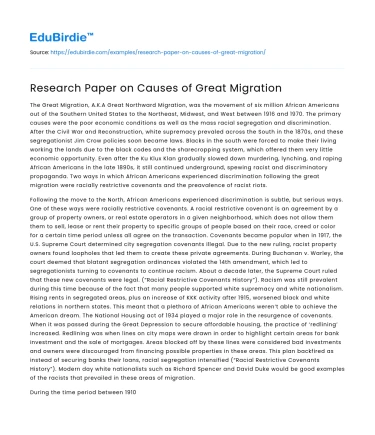The Great Migration, A.K.A Great Northward Migration, was the movement of six million African Americans out of the Southern United States to the Northeast, Midwest, and West between 1916 and 1970. The primary causes were the poor economic conditions as well as the mass racial segregation and discrimination. After the Civil War and Reconstruction, white supremacy prevaled across the South in the 1870s, and these segregationist Jim Crow policies soon became laws. Blacks in the south were forced to make their living working the lands due to the black codes and the sharecropping system, which offered them very little economic opportunity. Even after the Ku Klux Klan gradually slowed down murdering, lynching, and raping African Americans in the late 1890s, it still continued underground, spewing racist and discriminatory propaganda. Two ways in which African Americans experienced discrimination following the great migration were racially restrictive covenants and the preavalence of racist riots.
Following the move to the North, African Americans experienced discrimination is subtle, but serious ways. One of these ways were racially restrictive covenants. A racial restrictive covenant is an agreement by a group of property owners, or real estate operators in a given neighborhood, which does not allow them them to sell, lease or rent their property to specific groups of people based on their race, creed or color for a certain time period unless all agree on the transaction. Covenants became popular when in 1917, the U.S. Supreme Court determined city segregation covenants illegal. Due to the new ruling, racist property owners found loopholes that led them to create these private agreements. During Buchanan v. Warley, the court deemed that blatant segregation ordinances violated the 14th amendment, which led to segregationists turning to covenants to continue racism. About a decade later, the Supreme Court ruled that these new covenants were legal. (“Racial Restrictive Covenants History”). Racism was still prevalent during this time because of the fact that many people supported white supremacy and white nationalism. Rising rents in segregated areas, plus an increase of KKK activity after 1915, worsened black and white relations in northern states. This meant that a plethora of African Americans weren’t able to achieve the American dream. The National Housing act of 1934 played a major role in the resurgence of covenants. When it was passed during the Great Depression to secure affordable housing, the practice of ‘redlining’ increased. Redlining was when lines on city maps were drawn in order to highlight certain areas for bank investment and the sale of mortgages. Areas blocked off by these lines were considered bad investments and owners were discouraged from financing possible properties in these areas. This plan backfired as instead of securing banks their loans, racial segregation intensified (“Racial Restrictive Covenants History”). Modern day white nationalists such as Richard Spencer and David Duke would be good examples of the racists that prevailed in these areas of migration.
Save your time!
We can take care of your essay
- Proper editing and formatting
- Free revision, title page, and bibliography
- Flexible prices and money-back guarantee
During the time period between 1910 and 1930, white supremacists were infuriated with witnessing African American advancements. In order to reassert dominance and control over black communities, white nationalist groups resorted to violence. Another way that African Americans experienced discrimination following the Great Migration were racist riots. The most serious was the Chicago Race Riot of 1919. On July 27th, 1919, a 17-year-old African American boy named Eugene Williams was swimming with his friends in Lake Michigan.When he accidentally crossed the barrier between Chicago’s unofficial black and white area, a group of white men started to throw stones at him, hitting him, resulting in him drowning. When the police arrived, they refused to arrest any member of the group of white men whom other black witnesses deemed responsible for Williams’ death. This caused angry mobs of people to crowd the beach. Quickly, fights between mobs of black and white civilians broke out. After the police couldn’t tame the riots, the state militia was eventually called on the fourth day. However, the fighting didn’t stop until August 3. Shootings and street fights left 15 whites and 23 blacks dead, along with at least 500 injured, 60% of whom were black. To add insult to injury, about 1,000 black families were left homeless after rioters burned down their residences. The aftermath resulted in the attempt to implement zoning laws where housing would be formally segregated. However, African Americans and white liberals voted against such policies. President Woodrow Wilson blamed whites as the instigators for the riots in Chicago and Washington D.C., and condemned white supremacist ideologies (The Red Summer of 1919). However, the Chicago riot wasn't the only race-related riot. Other riots such as the East St. Louis and Lexington, Kentucky riot in 1917, the Ocoee, Florida riot in 1920, etc. were started in order to attempt to reassert white dominance, showing ways where African Americans experienced discrimination.






 Stuck on your essay?
Stuck on your essay?

